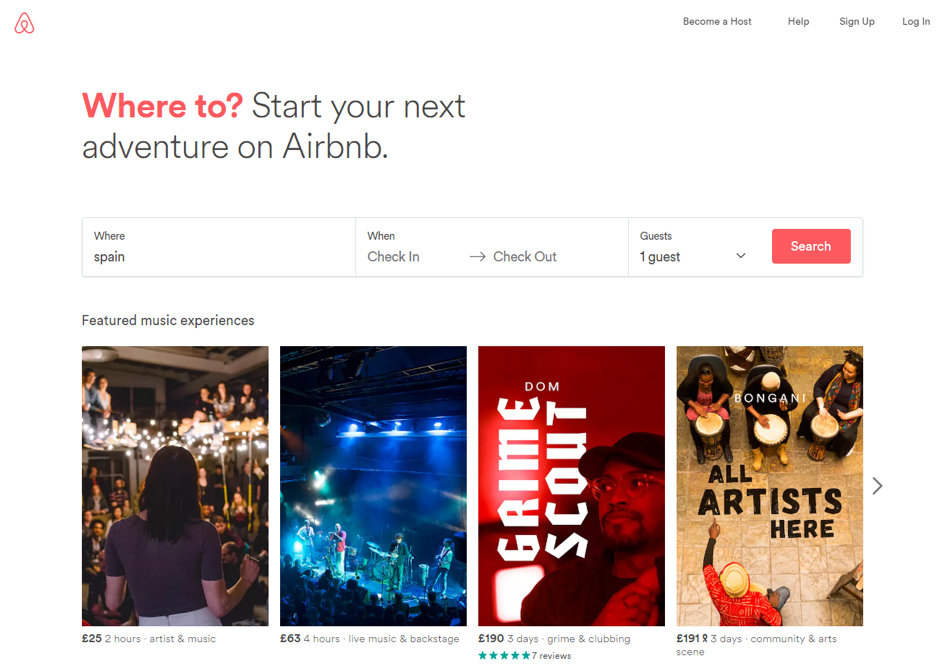
With Airbnb recently attracting another $1billion of funding, you can’t ignore the success of the second biggest tech start-up in US history. But how does it fair in terms of SEO?
It’s perhaps tempting to look at a brand such as this and think that its size alone is justification for copying what it does. This article, however, aims to warn you against making this presumption.
It’s vital to take a closer look at what others are actually doing with their SEO and look at how their site is performing.
This post will also highlight what Airbnb could do to transform its business if it made its site more attractive to Google.
Keywords
The first port of call for any client is to examine which keywords it already ranks for. At Zazzle, we prefer to do this by using Sistrix, Search Metrics and Ahrefs. These show that Airbnb.co.uk ranks for the following number of keywords:
Sistrix: 110,978
Search Metrics: 161,679
Ahrefs: 433,328
One question you might have is why does Ahrefs have more keywords than Sistrix and Search Metrics? This is simply because Ahrefs lists out the same keyword repeatedly if a site ranks multiple times.
Airbnb is undoubtedly a massive site from an SEO perspective. A pro tip here is not to look at a website at once, focussing instead on a single keyword. From that you can clearly see what needs improving and the changes you could bring in to increase the site’s ability to rank for that keyword. You then take those improvements and multiply them across all the other pages to see significant growth.
Given that Airbnb is a significant brand, we’d expect its name to be the most searched for keyword. However, location keywords also appear near the top of the list, such as:
- airbnb London
- airbnb Edinburgh
- airbnb Amsterdam
- airbnb Rome
What you would then expect to see is a lot more non-branded keywords if there wasn’t a strong focus on SEO.
The first non-branded keyword in this search was [things to do in London]. At the time of writing this article was ranking #9.
Focusing around this keyword and its target page should, therefore, tell us alot.
The target page that was ranking was the following URL:
https://www.airbnb.co.uk/things-to-do/london
This URL has a well optimised structure and we would not be able to suggest much improvement, if any. However, the meta title leaves scope for improvement:
‘The 30 Best Things to Do in London’
This does not come across as an optimised meta title. Firstly, it’s missing the brand name, which Google is putting in on its results page:

So this clearly suggests that our focus should be on ‘Things to do in London’. However, what are others doing?
Here’s how the rest of top 10 have written their meta titles:
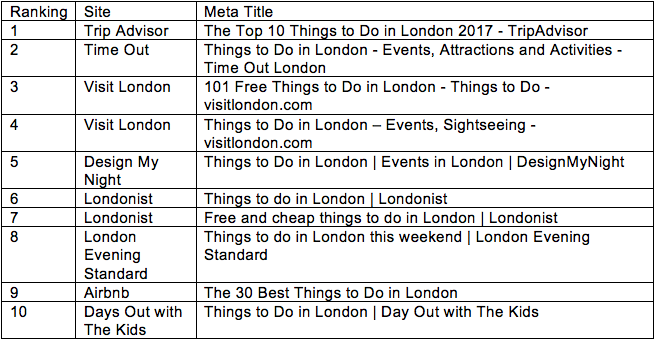
All other sites include the brand name, apart from Airbnb. Three sites make use of a number in a bid to boost their click through rate. One of these sites also includes the year.
We did a search for the keyword [The 30 Best Things to Do in London] and Airbnb ranked #1, with Trip Advisor ranking #2.
However, when we change that number to the following keyword [The 10 Best Things to Do in London] Airbnb ranks #10 and Trip Advisor regains top position.
In this situation, I would run some tests on the meta page titles to see what impact that has on rankings. The variations I would test would be the following:
[Control] The 30 Best Things to Do in London
[Variation 1] 30 Things to Do in London | Airbnb
[Variation 2] 10 Things to Do in London | Airbnb
[Variation 3] 11 Things to Do in London | Airbnb
To judge the success of the test we would track the rankings as well as the number of visitors that are coming to the landing page from Google organically.
My prediction is either variation 1 or 2 would perform better and variation 3 would only be the strongest if it was a pattern interrupt and would start to drop off over time.
Although these meta title changes would be nice to have, they aren’t going to dramatically transform the rankings overnight. For that we need to dig a little deeper.
So, the next obvious thing to look at is the content. I was surprised by the amount of content Airbnb had included on the page https://www.airbnb.co.uk/things-to-do/london
In fact, it surprised me how little it was performing after seeing the content on the page.
The first question was, is Google able to read this content?
Clearly, I was unable to fetch and render the site with Google Search Console because I don’t have access to their account.
I did, however, check the cached version. Strangely there was a redirect that appeared to display a different version of the page, which was only a search box.
Without trying this with Google’s fetch and render I’m unable to 100% rule out that this is not an issue. However, what I can state is it is not natural and consistent with the rest of the internet, when we do the same action in Google.
The check reviewed the text only version of Google’s cache. This did contain all of the content that was found on the page, which suggests to me that Google can read the content.
Next, I looked at the content itself as I wanted to ascertain if it was unique content. To do this I took one line of content and did a Google search surrounded by speech marks.
Places Page Duplicate Content
“Its a really nice big park right in the centre of London covering an area between Bayswater, Mayfair and Kensington/knightsbridge.”
The results were disappointing:
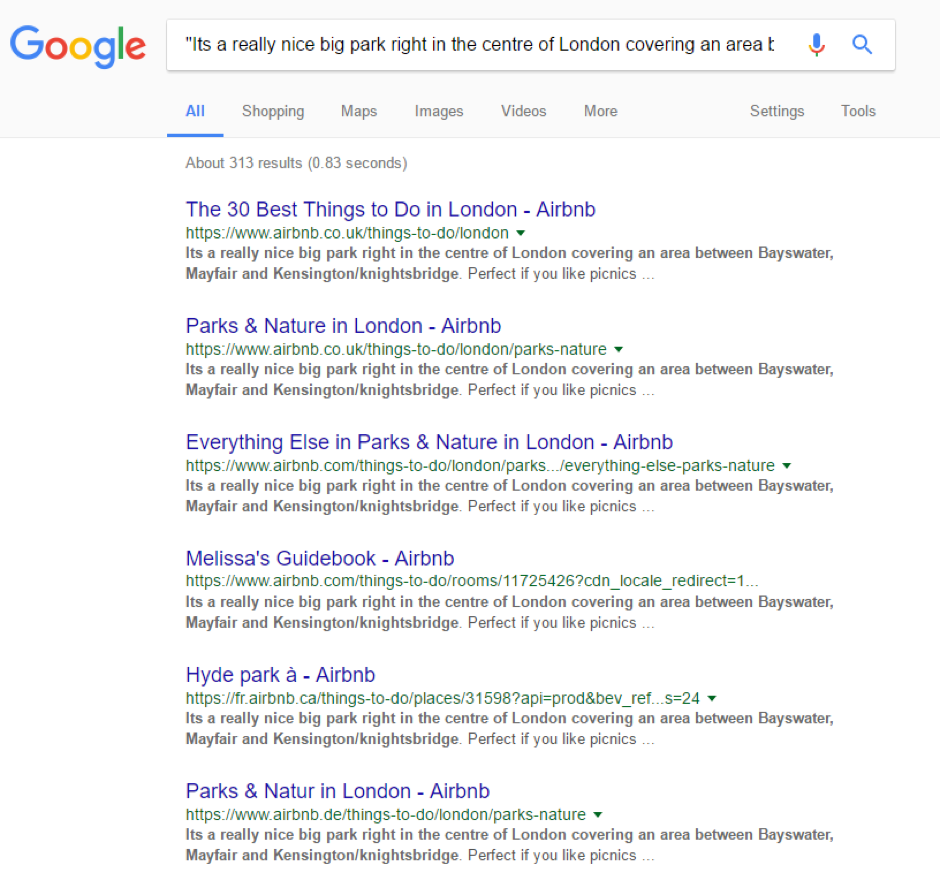
As you can see, that short line of text was used on multiple pages across the site. This means it is not unique content, making each page less likely to rank competitively in Google.
We also did the same search a couple of days later and the results were completely different, with our page no longer ranking.
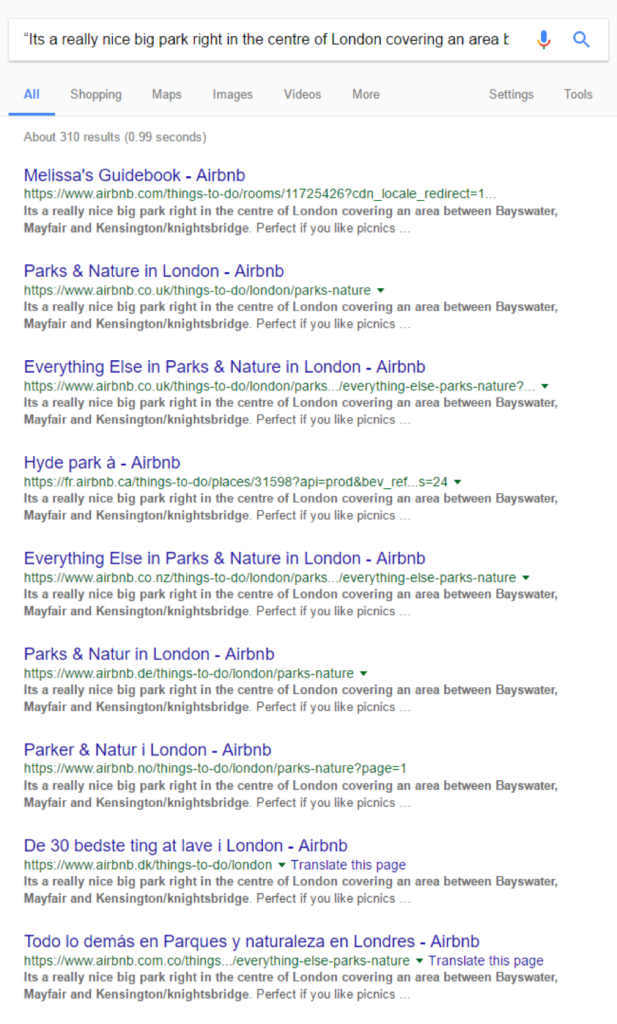
At this point, Airbnb was now ranking #10 for [things to do in London].
However, if this content was unique it would make a dramatic improvement in rankings. We would recommend adding some two or three paragraphs to add something unique and give Google a reason to rank the page.
Ahrefs states that [things to do in London] gets 73,000 visits per month and ranking #10 position would get us roughly 1.57% click through rate, based upon the Advanced Web Rankings CTR study.
Which means that from that keyword, Airbnb should have received 1146 visits. However, if we add some unique content to the top of the page and improve the main menu then we believe, based on previous successes, the page could rank within the top 3.
Ranking #3 for [things to do in London] would bring us in roughly 10.89% of the available views. This would translate into 7950 visits and represent an increase of nearly 600%.
Duplicate URLs
Unearthing the duplicate content issue also revealed pages in Google’s search results from other locations which had unusual URLs.

When tried as a UK site this loaded the following:
https://www.airbnb.co.uk/things-to-do/places/31598?api=prod&bev_ref=1487345665_d3VR9mp5PU7zzqXQ&s=24
Doing an ‘info: search’ on the above URL showed that it was not indexed. The next step was a ‘site: search’ with the above URL.
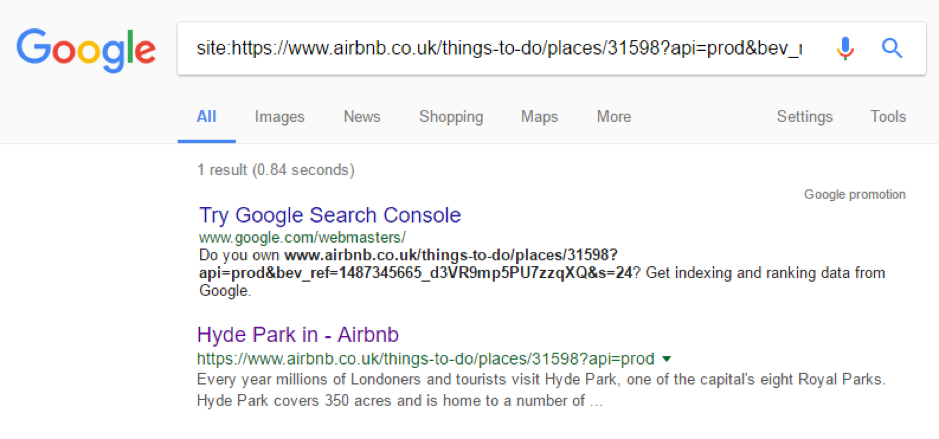
It came back with another strange URL that was indexed:
https://www.airbnb.co.uk/things-to-do/places/31598?api=prod
The above URL is a duplicate URL of:
https://www.airbnb.co.uk/things-to-do/places/31598
This means it is classed as duplicate content and is creating extra work for Google. We’d need to add a ‘rel canonical’ to both to tell Google that these are the same. This looks like:
<link rel="canonical" href="https://www.airbnb.co.uk/rooms/31598">
There needs to be a full review of all internal pages to make sure that these rel canonicals are being used to alert Google of any further such instances of duplicate URLs.
Crawl Bloat
A crawl bloat, also known as index bloat, is when a website has unnecessary pages in the search engines index. This creates more work for search engines such as Google. You’ll be rewarded by removing the amount of pages with low quality content.
Airbnb’s wishlist section contains one such issue.
It is the same as any other wishlist for ecommerce pages, where members of the public get to create wishlists of places they would like to stay. The issue here is that Google is indexing these pages even though they are not the sort of thing that people want to find in their search results.
When you do a search for the following string:
site:https://www.airbnb.co.uk/users/*/wishlists
There were more than 55,800 results in Google.
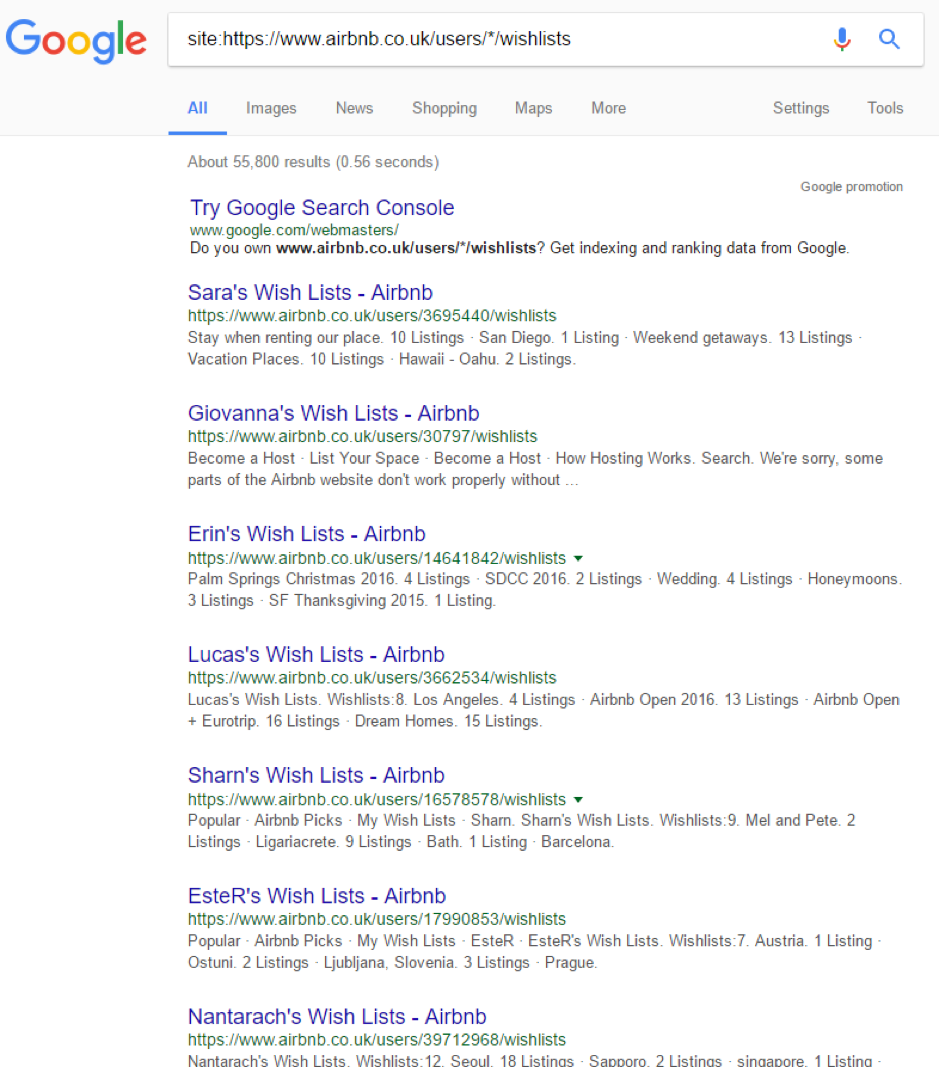
We would recommend adding the noindex, follow tag in the <head> section to all the wishlist pages, which will stop Google from adding these to its index.
Pagination
The guidebook section of the site lists out things you can do, in relation to the location in which you are staying. Often this list is quite long and spills over several pages.
For example, this is the URL to Melissa's Guidebook:
https://www.airbnb.co.uk/things-to-do/rooms/11725426
After the first 30 listings there is a little arrow at the bottom of the page, taking you to the next page. The link points to the following URL:
https://www.airbnb.co.uk/things-to-do/rooms/11725426?page=2
In fact, it goes on to another page after that:
https://www.airbnb.co.uk/things-to-do/rooms/11725426?page=3
To allow Google to understand what is happening here, we’d place a special markup code on the site, stipulating that the content goes over multiple pages. So for example the following URL:
https://www.airbnb.co.uk/things-to-do/rooms/11725426
Would have the following line of code in its <head> section.
<link rel="next" href="https://www.airbnb.co.uk/things-to-do/rooms/11725426?page=2" />
Then, on the following URL:
https://www.airbnb.co.uk/things-to-do/rooms/11725426?page=2
It would have the following code:
<link rel="prev" href="https://www.airbnb.co.uk/things-to-do/rooms/11725426" />
<link rel="next" href=”https://www.airbnb.co.uk/things-to-do/rooms/11725426?page=3" />
Here we are not only indicating the next page, but also the previous page.
Currently this is not happening and, as a result, there are URLs being shown in Google’s index that contain ?page=3 etc.
If Airbnb applied to rel next/prev to all paginated pages, Google would understand how the pages are constructed. This, in turn, would lead to less index bloat and ultimately higher rankings.
Blog
Airbnb’s blog is being hosted on a sub domain. This means any links it attracts will not directly benefit the root domain, with Google treating sub domains as their own separate domain name.
To fix this I would recommend to ‘reverse proxy’ the sub domain into a sub directory. So it will go from:
to
This would allow the blog to get higher rankings as it would benefit from the root domain’s backlinks. Plus, any new links the blog attracts will benefit all of the location pages.
Basically it is a win win for the main site and the blog. The only difficulty is setting up the reverse proxy in the first place. Some developers find this challenging, with many choosing to argue that it is not possible. My recommendation is to keep pushing and eventually you will get there. That or look for someone else who can actually carry this out for you.
Old Site Still Indexing
Just when you think you have finished, another issue has a habit of coming along. After the crawl bloat I came across a strange listing in Google that I hadn’t seen before:
https://www.airbnb.co.uk/locations/london
When I loaded this, the page took me to an old part of the site:
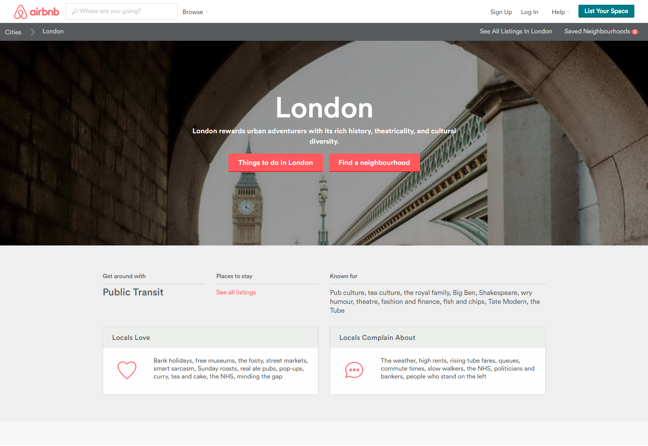
This section doesn’t look as though it should be live (it is using the old design) so it probably shouldn’t be indexed.
Instead of just blocking it, as with the wishlish section, we’d recommend that all of the /locations section get redirected [permanent 301 redirected] to the relevant section.
This will let Google know that this page is no longer available and will then take people to the new location permanently. Google will pass the majority of link equity from the old URLs the new URLs.
Dedicated Landing Pages
One area in which the site is underperforming is through a lack of dedicated pages to target popular keywords. One example is the keyword ‘cheap holidays’ which gets 301,000 searches per month. The homepage is currently ranking #46 for this at the time of writing this post.
Another keyword is ‘spare room’, which gets 282,000 views. Airbnb ranks #7 with https://www.airbnb.co.uk/rooms/4344167. The final example is ‘holiday lettings’ which gets 157,000 searches per month and is ranking #39 https://www.airbnb.co.uk/s/Brighton--United-Kingdom.
Each of these keywords has a high monthly search volume with the potential to bring in more traffic to the site. Not only that but they already rank for the keyword. So, creating a dedicated page to target each keyword should dramatically increase the chance of ranking well for these keywords and also their long tail variations.
Main Menu
One of the biggest things lacking from the site is a way to navigate to the ‘all the rooms’ and ‘things to do’ pages from the main menu. Currently these can only be accessed by using the search function. The focus of the main menu is to make sure that every internal page is linked to.
There needs to be a link to every section of the site that you’d want to be picked up by Google. This should include any new dedicated pages that are created as per the recommendations above. All the ‘things to do’ pages need to be categorised and then have at least one internal link from the main menu.
Also, it would be nice to see all the locations broken into categories – with the user able to select a geographical region then follow that to a smaller region and then individual country.
This would help users to find the right location and would ensure Google understands the structure of the site.
In Summary- My Actions
Ultimately Airbnb.co.uk is a hugely successful business and that’s a fact which cannot be contested. However, it is currently not following SEO best practice. I firmly believe it could see massive gains in traffic by adopting a few key SEO changes.
All these recommendations would not bear fruit overnight and they would require buy-in from many stakeholders. The best way to get this sort of project completed, and convince the right people, is to look for quick wins.
This means, for example, leaving the introduction of a new main menu until later and instead focus on more straightforward fixes that do not warrant so much buy-in.
These are the initial fixes I would make:
- Remove the wishlist pages from Google’s index first as this doesn’t take much effort to implement and you should start to see an improvement.
- Then assess variations of meta titles to see which increase rankings and click throughs.
- At the same time as this, you should push to fix the rel next/prev issue. This is slightly more complicated than the wishlist fix but shouldn’t come up against push back from other departments.
- Next I would be looking to review all the rel canonicals on the site and to make a list of all URLs that are incorrect. It would be best to setup rules, otherwise this task would take a long time.
- Then it’s on to the old locations section of the site. This will likely be in an existing roadmap, so you should not have to push hard to remove it. Instead you need to focus on what happens to it. The key thing here is to make sure that the developers 301 redirect all those pages to a new relevant location and don’t just 404 them or, worse, redirect them to the homepage.
- While content is being created I would recommend pushing for the blog to have a reverse proxy into the sub directory. This will transform your ability to attract traffic to your site using content marketing. It will also be the best way to build links to your site using high quality content. Getting the blog hosted in the correct location, hand in hand with a well-constructed content marketing plan, will create a real boost to traffic.
- By now you should start to see some real increases in traffic and, with that, you should have proven your case to get support from other departments. At this point I would be creating a list of the top 250 ‘things to do’ locations and getting unique content written for the top of each page. In fact, if you are short on time this is where you could source it to someone like us at Zazzle Media. We can work out which are the top 250 locations based on monthly search volumes and then plan to create category content on your behalf, which often is cheaper and quicker than hiring in your own staff, training them up and QCing all the work.
At this point it’ll be time for a promotion as a result of the amazing job you have been doing! It’s also now time to tackle the main menu and how you would change it. This will require a lot of research and many meetings but it will all be worth it. Main menus and internal linking are critical to any SEO campaign.
Sign up for our monthly newsletter and follow us on social media for the latest news.
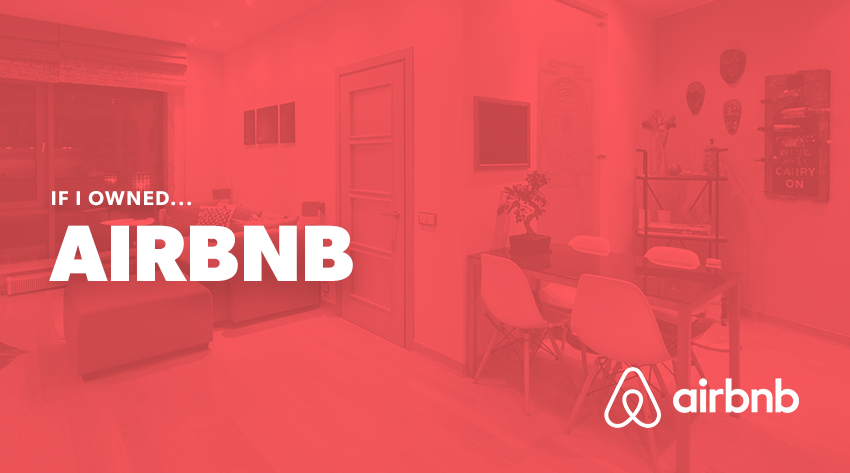




 Proudly part of IPG Mediabrands
Proudly part of IPG Mediabrands